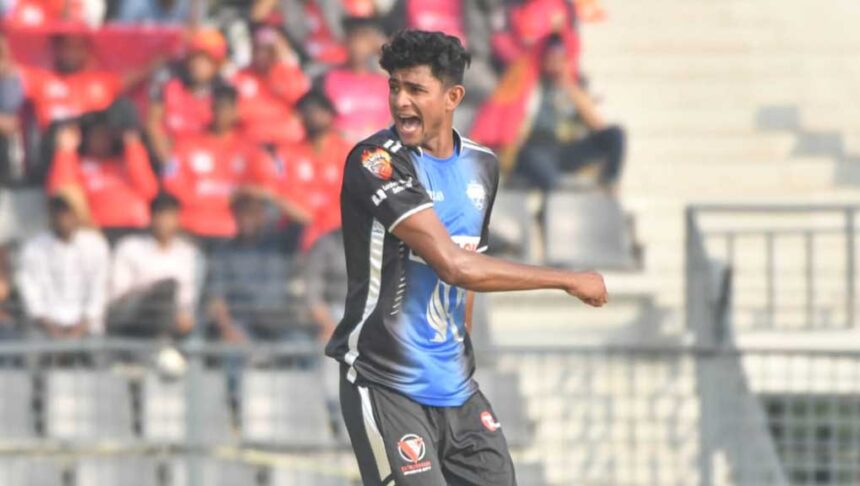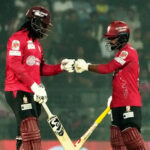In the BPL, Nahid Rana was made to play five matches in just nine days for the Rangpur Riders, and by Tuesday’s match against Dhaka Capitals, fatigue had clearly set in. His pace was much slower during the game.
After finishing a press conference at Sylhet International Stadium, Nahid walked out into the gallery area. As he passed by, the crowd erupted in cheers, shouting his name and calling out to him. Among the voices, one stood out: “Take care of your body, brother… stay fit.”
Nahid waved at the crowd with a smile. Just moments earlier, most of the questions at the press conference had been about his fitness, workload, and concerns about his body despite his potential.
He’s been charging ahead with great speed, but the fear of a fall always looms. In the BPL, that concern has only grown. The match against Dhaka Capitals was his fifth in just nine days. The physical toll on his body is undeniable.
This fatigue is visible in his bowling. In the match against Dhaka, where he took 3 wickets and was named Player of the Match, there was no doubt about his effectiveness. However, his real asset is his pace. In the previous match, his speed had already dipped slightly. In this one, it dropped even further. Apart from four or five deliveries, the rest were all under 140 km/h, with a few even dipping below 135 km/h, including slower balls.
He bowled four wides in his first over. It was the first time he had picked up a new ball in this series, and perhaps it took him some time to get control. But his exhaustion and fatigue were clear in his face and his bowling. His speed was noticeably lower from the start.
The opposition wasn’t too strong on that day. After giving away 12 runs in his first over, Nahid composed himself but couldn’t find his usual pace.
Walking back to the dressing room after the press conference, he acknowledged his fatigue, but the 22-year-old fast bowler refused to dwell on it. Explaining his drop in pace, he said, “It’s just about rhythm… not every day your rhythm stays the same. The body doesn’t always respond the same. Otherwise, I’m fine, my body’s fine. There’s no problem. The physio and the management are looking after me.”
His explanation makes sense—speed will naturally vary, but playing so many matches in quick succession will inevitably lead to a drop in pace.
Nahid didn’t raise any objections about playing so often. For a young cricketer, the thrill of the present moment often outweighs concerns about the long-term effects. He wants to play every match. However, those in charge must recognize the deeper implications.
The real question lies with them: Have they considered the risks of making Nahid play five matches in nine days, or has the franchise’s interests been prioritized? Was it truly necessary to play him against Dhaka, especially after playing just the previous day?
This BPL is a huge challenge for him. He’s never played this many matches in such a short span in his career. The team management’s decisions about how many matches he should play and how much rest he should get have been questioned from the very beginning of the tournament. Now, the fear is growing, as there are real concerns about the long-term effects of overplaying him.
In T20s, although bowlers only bowl four overs, the intensity required in those four overs, the focus needed, and the physical and mental strain are comparable to that of ODIs.
The injury history of young, pace-heavy bowlers like Nahid adds another layer of concern. Mashrafe Bin Mortaza, who once rattled the cricketing world with his pace, is a constant reminder of how overuse can damage a body. He was broken by excessive workload, and the country’s cricketing hopes took a hit. Similarly, other pace bowlers like Mohammad Sharif, Talha Jubair, and later, even Ibadat Hossain, have gone through injury setbacks that kept them away from the field for long periods.
Nahid’s pace is even greater than theirs. He is the first bowler in Bangladesh’s history to bowl at 150 km/h, and he consistently maintains that speed. But his body is still not as strong, and his muscles are not as developed. He is a gem for Bangladesh cricket and for world cricket, and his care is essential.
At the press conference, Nahid downplayed the talk of injuries.
“About the injury… if a person goes into battle, getting shot is part of it. In cricket, getting injured is inevitable. As for maintenance, I’m doing it myself. The BCB (Bangladesh Cricket Board) has set a schedule, and I’m following it. Whatever comes next, Alhamdulillah.”
His words reflect youthful optimism, but he must realize that, just like in battle, injuries can end careers. The fight isn’t just about performance—it’s about taking care of oneself to avoid serious injury.
Nahid did emphasize that they are being careful, though.
“Of course, the national team’s physio, Bayezid Bhai, is in touch, and I’ve also been talking with our Rangpur team’s physio, Sajib Bhai. We make sure everything’s in order. I last played a One-Day International in the West Indies, after which I had a break. I didn’t play any more matches. The BCB has given me a plan to maintain my fitness, and so far, they’ve said that my body is fine, and I feel that it is too.”
The problem, however, is that injuries don’t give warnings. Yes, taking breaks between matches can help, but there’s always a chance of injury. Playing back-to-back matches increases the risk. Sometimes, the impact of an injury is only realized later, and that’s when it can be dangerous.
So far, the national team has managed him carefully, but these five matches in the BPL tell a different story. After the press conference, Rangpur’s manager reassured that they are following the advice of the national team’s physios and trainers. Still, in Bangladesh’s cricket culture, doubts persist. Everyone knows the story of the golden egg-laying goose and the dangers of overuse.






